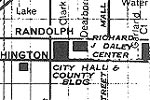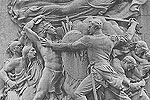
The Loop
The history of early Chicago begins near the mouth of the Chicago
River. As early as 1673 the river attracted the French explorers
Father Jacques Marquette and Louis Jolliet. After they discovered
the waterway, it became a major route for French voyageurs,
engages,
and explorers, who raised the flag of the Bourbons over the western
frontier. In 1763, after the French and Indian War, the territory
passed to British control. The mouth of the river was a natural
place for a settlement. But no permanent settlement was made
in
the area until about 1781 when Jean Baptiste Point du Sable,
a French-speaking black man, arrived and built a cabin on the
north
bank of the main stream, where the Chicago River flows into the
lake. Du Sable's home became a center of economic activity in
the Northern Illinois country. Trappers and traders stopped at
Jean Baptiste's to sell their furs or simply to visit as they
plied their trade along the rivers and lakes of the Old Northwest..
The American victory over the British in 1783 in the War of
Independence saw the future Chicago area come under the new government,
nominally
at least. But the war did not bring any significant changes in
the area. Logistically it was difficult for the fledgling republic
to assert its control over the territory. British troops and
a sizeable number of French-Indian and British traders still
held
control. The campaign of General "Mad" Anthony Wayne
against pro-British Indians in the 1790s ended with the Treaty
of Greenville in 1795. This treaty recognized the mouth of the
Chicago River as a strategic place, which was ceded to the United
States government by the Indian nations. Wayne advised the Secretary
of War to establish a fort there, but the government was unable
to do this until the summer of 1803, when troops arrived to erect
the first Fort Dearborn under the command of Captain John Whistler.
By the spring of 1804 a wooden fort stood just about where the
south end of the Michigan Avenue Bridge stands today
(See
Fig. 1).
The establishment of a military installation here immediately
attracted more traders and Indians. DuSable had already left the
area by the time the army arrived. In 1800 he had sold his cabin
to Jean La Lime and disappeared from history. Four years later
John Kinzie arrived, and he soon became the principal fur trader
in the area. Fort Dearborn became the center of economic activity
as trappers and traders gathered around it. The small settlement
was already ethnically diverse. Most of the solders were American,
whereas the traders were American, British, and Scotch, and they
traded with French-Indian engages.
1
of 11
next
»
|
 |

|
 |


Map
of the Loop. »

Figure
1: Michigan Avenue Bridge Bas Relief. »
|